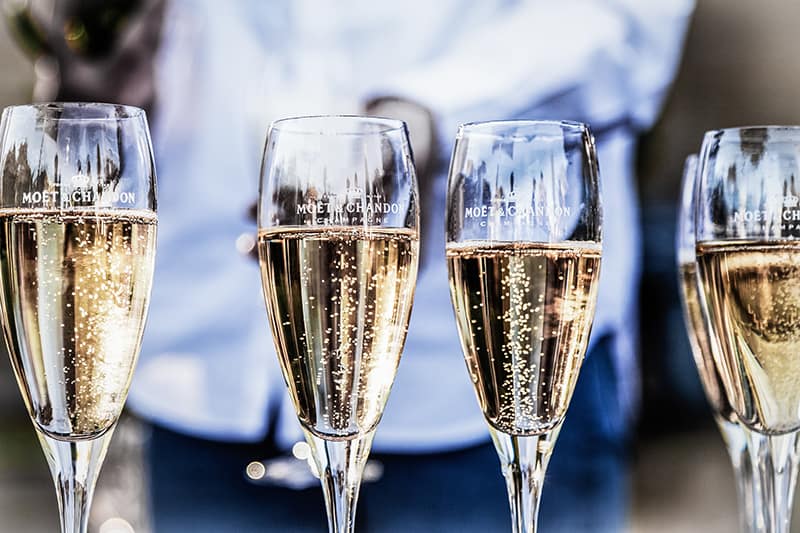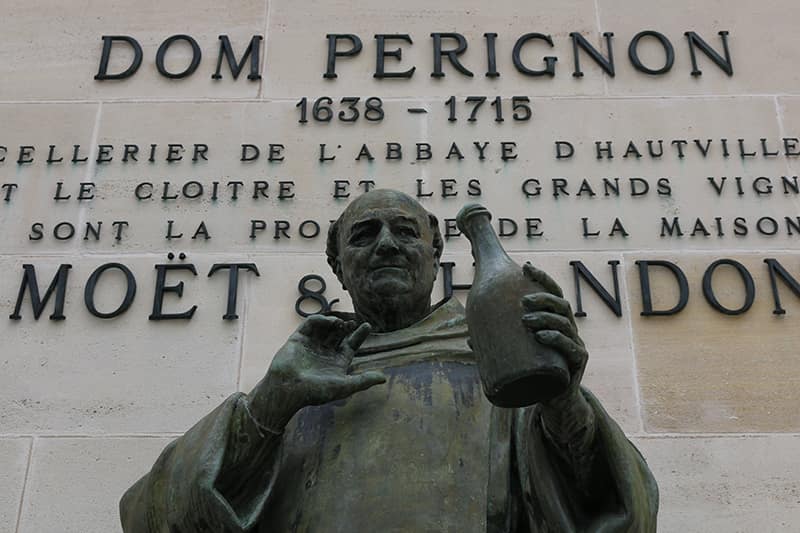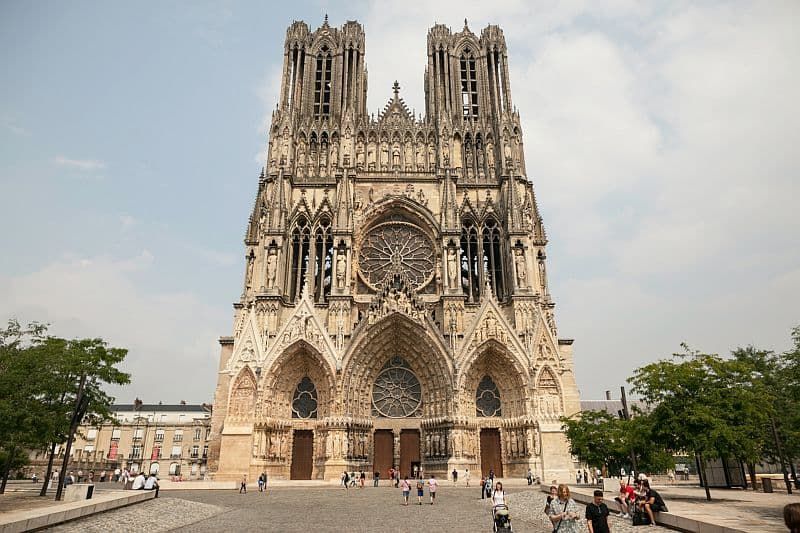Champagne is renowned for being the most exclusive celebratory drink in the world. Consumed at social gatherings all over the globe, it’s used for toasts at weddings and seeing in the New Year. But the real question is, do you know your champagne from your prosecco?
Well, European Waterways is here to cover everything you need to know about the Champagne region of France and the eponymous drink; from who invented it, to all about its home in the North of France. With facts so good you’ll impress everyone at your next party, this article is an unmissable read that’ll bring you up-to-speed on the truth behind the bubbles!
What is champagne?
Champagne is a sparkling wine that’s pale gold to pink in colour and has an alcoholic percentage of 11-13%. It’s usually made from the pinot noir, chardonnay, or pinot Meunier varieties of grape. Compared to other sparkling wines, it has a relatively dry flavour and has tasting notes of almond, apple, and citrus fruits. The world-famous sparkling wine is light on the palate because of its delicate bubbles, which balance its high acidity.
Is all French sparkling wine champagne?
What specifically defines champagne from other French sparkling wines is that it’s not champagne unless it’s made specifically in the Champagne region of France. Regulated with a Protected Designation of Origin status by the European Union, only bottles produced in the region can be called champagne. That said, many other countries outside of Europe also respect this rule.
Who invented champagne?
This famous sparkling wine was invented in the northernmost region of France by the Champenois, though Dom Perignon, who is affectionately known as the ‘Father of Champagne’, is credited with being the one who perfected its production. Created after a fashion, it started its story as a weak red wine that wasn’t particularly enjoyable to drink!
In the 1st century AD, the Champenois found that they were unable to compete with the neighbouring region of Burgundy when it came to making red wines. The grapes grown Champagne received less favourable weather conditions, meaning that they never fully ripened. Wines produced here were therefore pale and more acidic than the red wines made in Burgundy. They were also much less popular with consumers.
How do you make champagne and how is it different from prosecco?
The method used to make champagne requires the wine to be aged inside glass bottles. It starts life in the same way that most wines do. Grapes are harvested from the vineyards and are fermented, meaning that yeast and sugar is added to the grape juices.
When the yeast feeds on sugars in the grapes, carbon dioxide is released into the wine, giving it a slightly fizzy texture. To make a sparkling wine, the containers with the wines are sealed, to keep the gases inside. Different sparkling wines are fermented in different ways, giving them different flavour profiles, and making them stand out from one another.
Its grapes are twice fermented, which is the same as the process used to make prosecco. However, prosecco is fermented in stainless steel vats and champagne is twice fermented in glass bottles. The result is two very different sparkling wines. Champagne retains a dryness and develops a very complex flavour profile. The prosecco develops a much simpler flavour profile and usually stays much sweeter.
Bottling fermenting wine in glass may seem sensible if a winemaker wants to create complex flavours, but it was a very hazardous way to make wine! The build-up of carbon dioxide inside the glass bottles during winter months meant that historically, it was prone to spontaneously explode in cellars! A problem that would eventually be solved by none other than Dom Pérignon himself.
How old is champagne and what is the history of champagne?
Champagne was invented as long ago as the 1st century AD by the Romans, but it wasn’t the drink we now associate with this pale sparkling wine. The Romans set up vineyards in the northernmost region of France, known then as ‘Gaul’ and produced wines that were popular to locals.
By the 9th century, the people of France knew it as the drink associated with kings, because it was drunk at the coronations of French Kings that took place in Reims Cathedral. The French fizz became popular in England, where it was well-consumed by the nobility and elite of society, and outwards to the rest of Europe – to be sold at market.
Many great things are created by happy accidents, and champagne is no exception! It was created as a result of the climate in Champagne. Freezing winters in the region meant that wines stored in cellars there would not ferment properly. The absence of heat in winter months paused the winemaking process until spring came around and resulted in a double fermentation process.
But champagne makers had a huge problem. The glass bottles that champagne was aged in tended to spontaneously explode in champagne cellars because of a carbon dioxide build-up inside them. Winemakers of the Champagne region lost a significant proportion of the bottles they made, meaning they had less champagne to sell. This drove the price of champagne up and made it a drink only affordable to the wealthiest people. Champagne therefore became known for being served at royal courts, and as a drink provided at special occasions.
Demand for champagne at the French court increased in the late seventeenth century and resulted in the founding of many of the big-named champagne houses in the eighteenth century. It was from 1693 that Dom Pérignon has been credited with having improved many of the techniques used to improve champagne production. This famous French monk became a master in viticulture at the Abbey of Saint-Vanne in the Champagne region. Dom Pérignon was the first to champion the use of the pinot noir grape to make champagne and he perfected the second fermentation process we associate with champagne making.
Dom Pérignon was also responsible for the production of new corks that used hemp, to help prevent champagne bottles from exploding in the cellars. Later, the French inventor, Adolphe Jacquesson, designed the wire cage we now associate with holding down corks, to securely hold them in place.
How should you drink champagne?
You can’t drink champagne without a champagne flute. Specially designed to trap the air bubbles and retain the sparkling nature of champagne, the elongated flute produces a steady stream of fizz. Carefully raised to your lips, this elegant glass can be gently sipped at, for a sophisticated touch at celebratory occasions.
What foods can you pair champagne with?
Champagne is best served with light appetisers like oysters and blinis, or starters like devilled eggs and prawn cocktails. Surprisingly, it has been recommended as the wine best served with fish and chips because the acidity and dryness of champagne cuts through the fats in this classic dish.
How can I visit the home of champagne?
If this article has whetted your appetite for a glass of champagne, then step aboard hotel barge Panache, where you’ll be greeted with a champagne flute full of the dry, sparkling wine. We welcome you in style and take you on an exclusive tour of the Champagne region. You’ll feel like an A-lister as our on-board gourmet chef pairs your champagne with the very best in French cuisine.
To find out more about a barge cruise on Panache, then take a closer look at the full Classic Itinerary here >
 English
English
 Spanish
Spanish French
French German
German Norwegian
Norwegian Portuguese
Portuguese Swedish
Swedish Italian
Italian Russian
Russian Simplified Chinese
Simplified Chinese Japanese
Japanese


